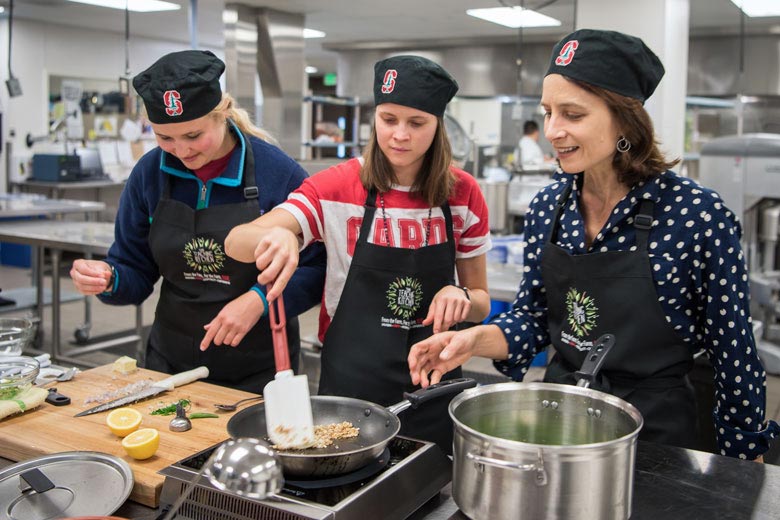
Stanford undergrads Kady Richardson and Ashley Westhem join lecturer Kristen Haring in cooking Julia Child’s recipes as part of a course on the history of American leisure. (Image credit: Keith Uyeda)
Students in a Stanford American studies class this winter quarter discovered how entertainment and education intersected in American culture during the 1960s and 1970s. The focal point was none other than the TV chef of that era, Julia Child.
The course, America at Play: A History of Leisure in the United States, was the first humanities class to make use of the Teaching Kitchen @ Stanford, which opened in 2015 for the purpose of hosting cooking classes. Stanford lecturer Kristen Haring designed the class as a hands-on practicum to enable her students to more directly evaluate Child’s program.
Haring’s class examined critical and historical materials pertaining to Julia Child’s television program, The French Chef, and watched selected episodes of the show. During their class, the students took notes on the episode “Vegetables the French Way” with the goal of replicating the recipes in the teaching kitchen. In another class project – supported by an ArtsCatalyst grant and done in coordination with the Cantor Arts Center – students completed paint-by-numbers kits, to determine what can be learned through the commercialized leisure practice of kit-assembly.
Haring said, “Each of these hands-on activities replicates an historical activity that aimed to teach or to introduce something. That way, doing the activity even once provides the opportunity to investigate the educational aspect.”
During the current quarter, Haring is teaching Objects of History: From Material Culture to Making. The course focuses on what historical knowledge can be gained through physical interactivity. In collaboration with the Cantor’s Art + Science Learning Lab and with Professor Hideo Mabuchi’s applied physics class The Questions of Clay: Craft, Creativity and Scientific Process, students will replicate objects in the Cantor’s collection.
Learning from The French Chef
On Feb. 19, the class sought to answer the question posed by Haring: “Can you learn to cook something just by watching an episode of Julia Child’s The French Chef?” David Iott, Stanford’s culinary educator and training executive chef, was in attendance to lend guidance.
The six students paired off into teams of two and began to attempt to cook the vegetable recipes. With students of varying skill, the practicum in the kitchen proved to be an excellent way to test the accessibility of Child as a teacher and to also examine her cooking as a form of leisure.
Michael Jokl, a senior history major who described himself as a more experienced cook, said that he “found Julia Child very relatable even though the show was shot in the 1960s.” He added, “She doesn’t make cooking seem intimidating even though it very much is for most people, and she makes it seem very enjoyable.”
Through the practicum in the kitchen, students were able to successfully judge the educational value of The French Chef along with its entertainment value as it fit into the bigger picture of American leisure through history.
“I think her show was a little bit of entertainment and education,” said Matt Jeakle, a junior majoring in American studies. “I feel like people in the 1960s probably watched her show and thought to themselves, ‘I’ll give that Julia Child recipe a try.’ I think it would have been great at eliciting participation from its viewers because of the accessibility, and how fun she made it look.”
Understanding American leisure
In addition to studying the educational and entertainment value of The French Chef, the practicum allowed students to peer into the past to gain a deeper understanding of what American leisure activities were like during the 1960s and 1970s.
“I have a greater understanding of how this show contributed to the evolution of the American food show. The French Chef was not hyper-produced like cooking shows today. Julia Child did not have a cultivated TV persona, she was just there to actually demonstrate cooking and show recipes,” Jeakle said.
Haring asked students, “What do you think is being taught in the episodes with regard to cooking and, more broadly, to American culture?”
Freshman Elena Lund tied Child’s show, and her experience cooking, back into the course themes and a broader picture of American leisure in the 1960s.
Lund said, “I think her show is a great representation of American consumerism at the time, and how consumerism was changing. I think she changed the way people thought about food.”
Senior Holly Grench added: “I see Child exemplifying the inspirational and aspirational strengths of the edutainment medium. While she provided instruction, her impact was felt deeply in the motivation of her viewers to try something new in their kitchens.”
Haring noted, “Child was changing American culture and views of eating by teaching what meals to eat, as much as she was teaching how to cook them.”